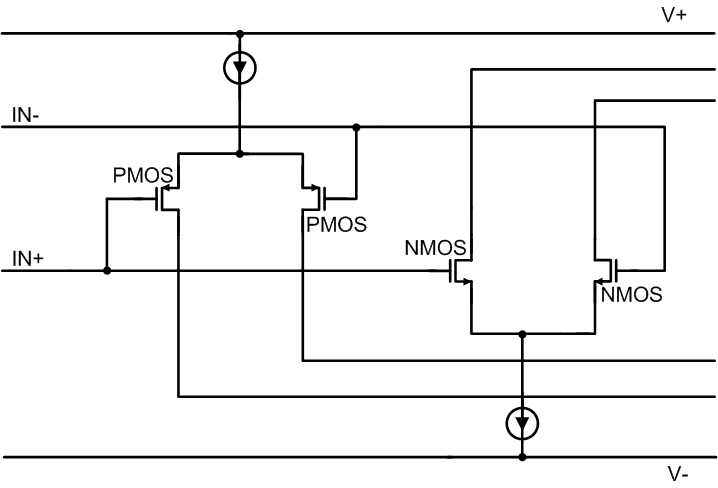SBOSAM4 December 2024 TLV9141 , TLV9144
PRODUCTION DATA
- 1
- 1 Features
- 2 Applications
- 3 Description
- 4 Pin Configuration and Functions
- 5 Specifications
- 6 Detailed Description
- 7 Application and Implementation
- 8 Device and Documentation Support
- 9 Revision History
- 10Mechanical, Packaging, and Orderable Information
パッケージ・オプション
メカニカル・データ(パッケージ|ピン)
サーマルパッド・メカニカル・データ
発注情報
6.3.2 Common-Mode Voltage Range
The TLV914x is an 18V, true rail-to-rail input operational amplifier with an input common-mode range that extends to both supply rails. This wide range is achieved with paralleled complementary PMOS and NMOS differential input pairs, as shown in Figure 6-3. The NMOS pair is active for input voltages close to the positive rail, typically from (V+) – 1V to the positive supply. The PMOS pair is active for inputs from the negative supply to approximately (V+) – 2V. There is a small transition region, multichannel typically (V+) – 2V to (V+) – 1V, in which both input pairs are on. This transition region can vary modestly with process variation. Within this region PSRR, CMRR, offset voltage, offset drift, noise, and THD performance can be degraded compared to operation outside this region.
Figure 5-17 shows this transition region for a typical device in terms of input voltage offset in more detail.
For more information on common-mode voltage range and complementary pair interaction, see the Op amps with complementary-pair input stages: What are the design trade-offs? Analog Design Journal.
 Figure 6-3 Rail-to-Rail Input Stage
Figure 6-3 Rail-to-Rail Input Stage